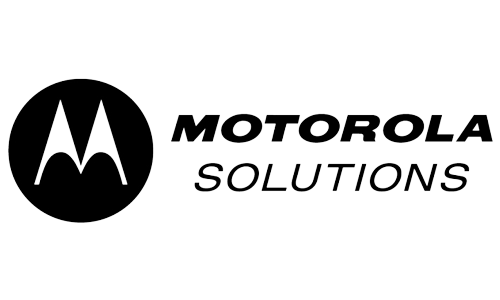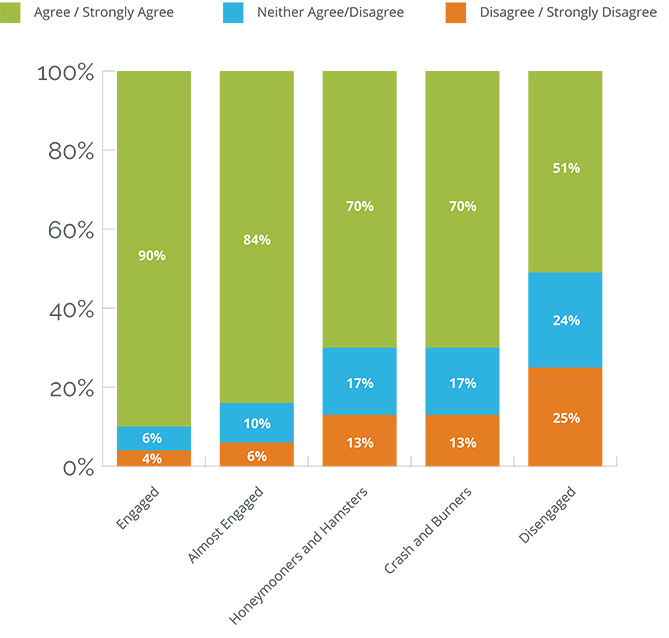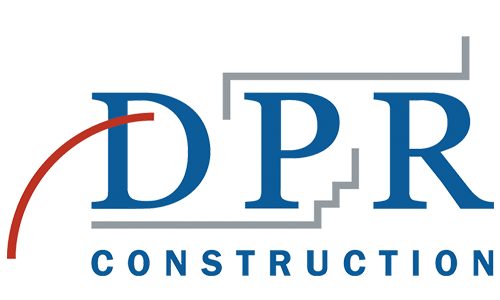Chapter 18
Give them a voice
“We try to have as many channels for expression as we can, recognizing that different people – and different ideas – will percolate up in different ways.”
– Laszlo Bock, SVP of People Operations, Google
In order to discover hidden potential in their employees, many of today’s most innovative, influential, and forward-thinking companies follow these two rules religiously:
- Never assume you know what your employees think – let them tell you
- Take the risk of sharing too much, rather than miss out on an opportunity to connect, collaborate, and learn from one another
Employee engagement surveys are one way to solicit feedback and take the pulse of engagement. There are a million survey questions you could ask. Chose the topics that matter the most at your company.
SAS, for example, focuses on open communication, respect from fellow employees, transparency into career paths, and being treated as a human being.
Google’s largest employee survey,
Googlegeist, collects feedback on hundreds of issues. Once the results are in, employees volunteer to solve the biggest problems and work in teams across the entire company. One recent outcome is a new engineering to product management job rotation program. Another one is a company-wide pay raise.
Recreational Equipment, Inc. (REI), no. 69 on Fortune’s
100 Best Companies to Work For in 2014, uses
company intranet software to get input and exchange ideas.
Company campfire, launched in 2012, features blog posts by REI executives, employee awards, products and research. Employees can comment, ask questions, and debate issues.
Listening to employees can be as simple as asking a few questions face-to-face. The Institute for Corporate Productivity (i4cp) recommends conducting
stay interviews – an alternative to
exit interviews – to discover what makes employees happy, productive, and loyal. Stay interviews also allow managers to resolve minor issues, demonstrate to employees that they are valued, and prevent unwanted turnover.
Once you have your feedback, what will you do with it?
Google, for one, believes it’s just as important to empower employees to find solutions as it is to encourage them to speak up. On top of
Googlegeist and a host of other surveys, Google routinely reviews GUTS (Google Universal Ticketing Systems) – a place for employees to raise concerns about anything, similar to New York City’s 311 line. An urgent case may call for a FixIt, a 24-hour stretch when the entire company focuses on solving a specific problem.
Is there a downside to openly discussing problems and solutions with employees?
Google’s Laszlo Bock believes it’s a matter of managerial skill:
“Some people will argue that giving employees so much information and such a loud voice leads to anarchy, or to a situation where, since everyone’s opinion is valued, unanimity is impossible, as anyone can object and derail an effort; an environment where 10,000 people can say ‘no’ but no one can say ‘yes.’ The reality is that every issue needs a decision maker. Managed properly, the result of these approaches is not some transcendent moment of unanimity. Rather, it is a robust, data- driven discussion that brings the best ideas to light, so that when a decision is made it leaves the dissenters with enough context to understand and respect the rationale for the decision, even if they disagree with the outcome.”
If you want your people to fully engage in their work, leave room for their own voice and initiative.
Let them take part in decision making. Be open to new ideas. Support employee-led programs.
An inspiring mission and shared insights are only meaningful to those employees who can put their knowledge and beliefs into action.
In the words of Laszlo Bock,
“People look for meaning in their work. People want to know what’s happening in their environment. People want to have some ability to shape that environment. Mission. Transparency. Voice. These three components of our culture create a virtuous cycle of attraction, community, engagement, and innovation.”
Tired of counter-culture, twenty-second century ideas of greatness?
Here’s how a nice conservative company does it.
Edwards Jones (no. 4 on Fortune’s 100 Best Companies to Work For in 2014) is the fourth largest financial advisory firm in the US, rivaling Starbucks in number of locations.
At the end of 2008, Edward Jones was facing a cost-cutting dilemma: cut jobs or find other ways to save $100 million to offset lost revenues.
The company turned to its associates to come up with cost savings ideas.
The management picked the best ideas and rewarded the winners with a pair of tickets to the MLB All Star Game in St. Louis. When the results were tallied, Edward Jones ended up saving $120 million – plus the jobs and commitment of its people!
















 In 2013 TINYpulse surveyed 40,000 employees from 300 companies around the world to find out that only 42% of employees know their organization’s vision, mission, and values.
The study concluded that “too many executives are not communicating and reinforcing their company’s guiding principles and mission,” and the result is apathetic, disengaged, or actively disgruntled employees.
Talking and writing does not always equate with reaching your audience. When asked about an opening night of one of his plays, George Bernard Shaw famously replied: “The play was a great success, but the audience was a dismal failure.”
How can companies avoid failing their internal audiences?
Communicate opportunistically, as well as at regular intervals, through any means appropriate to the occasion. Promote openness and transparency. Promptly address concerns. Give employees a clear line-of-sight: where they are going, how they are doing, and where they fit in.
In a 2013 whitepaper, A New Way to Work, Unify (formerly Siemens Enterprise Communications) offers these tips to more engaging employee communications:
In 2013 TINYpulse surveyed 40,000 employees from 300 companies around the world to find out that only 42% of employees know their organization’s vision, mission, and values.
The study concluded that “too many executives are not communicating and reinforcing their company’s guiding principles and mission,” and the result is apathetic, disengaged, or actively disgruntled employees.
Talking and writing does not always equate with reaching your audience. When asked about an opening night of one of his plays, George Bernard Shaw famously replied: “The play was a great success, but the audience was a dismal failure.”
How can companies avoid failing their internal audiences?
Communicate opportunistically, as well as at regular intervals, through any means appropriate to the occasion. Promote openness and transparency. Promptly address concerns. Give employees a clear line-of-sight: where they are going, how they are doing, and where they fit in.
In a 2013 whitepaper, A New Way to Work, Unify (formerly Siemens Enterprise Communications) offers these tips to more engaging employee communications:











